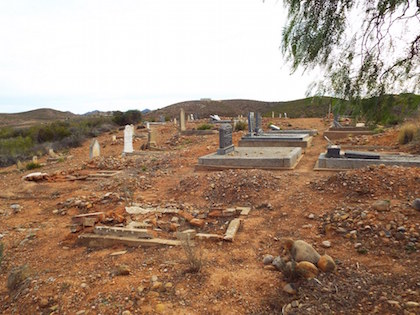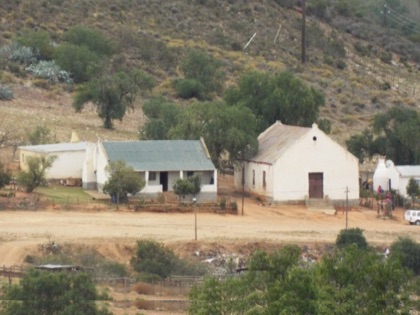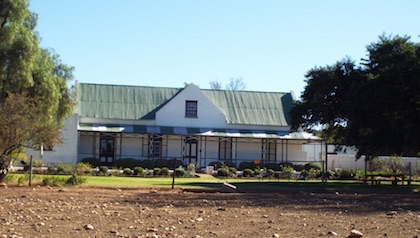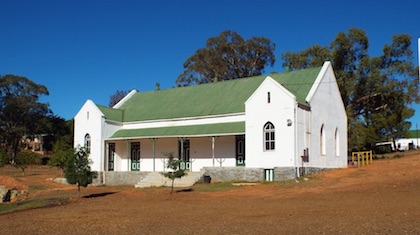A Brief History of the Village including Some Key Families
De Rust is located at the Southern end of Meiringspoort and was originally a point where travellers camped before moving through the “Poort”.
The Post Office in De Rust was originally opened in 1858 as De Rust (Meiringspoort) and the first Postmaster was P. J. Meiring. In 1860 the name was amended to De Rust but in 1864 the name was changed to Meiringspoort De Rust. In 1872 the name was amended again to Meirings Poort and remained as such until December, 1905 when it was renamed back to De Rust.
On 23 August, 1901 and again 19 October, 1901 Boer forces under Commandant Scheepers, entered Meiringspoort and ransacked the Post Office. In 1905 it was refitted and transferred to new premises.
The Old Graveyard The “Old Graveyard” on the De Rust Koppie is in all probability the oldest graveyard in the Village, even pre-dating the one adjacent to the Church in Le Roux Street. (At this stage we are still seeking additional information on this from some of the original families.) However, the graves of the original owner of the farm De Rust and some other families are situated on the Vredelust portion of the consolidated De Rust farm property which has a number of separate titles.
Ou Lokasie -“Ou Lokasie” was the site of the original village for the farmworkers of De Rust. However, it outgrew the original site situated at the entrance to Meiringspoort. In the early 1980's the Schoeman family agreed to exchange a portion of land where Blomnek is now situated in exchange for the land situated at the “Ou Lokasie”.
Following the move of the community from Ou Lokasie to Blomnek many of the old structures which were in poor condition were demolished but still leaving a number of houses and the church which still stand today.
The Church at “Ou Lokasie” - The church at “Ou Lokasie” was built some years after the church in the Village which is a registered Provincial Heritage Site. (Additional details will be added as soon as they are available.)
 |
 |
|
| The Old Graveyard | The Old Church at "Ou Lokasie" |
The Village was formally established in 1899 by transferring a portion of land owned by the Schoeman Family of Vredelus, directly adjoining De Rust.
The story of this is explained more fully in “South Magazine” December, 2011 edition as follows:
“Around De Rust the descendants of Schoeman, Le Roux, Delport and Terblanche continue to farm the lands of their ancestors. They are fourth, fifth and sixth generation storytellers with marvellous tales of the Boer War, the rise and fall of the ostrich industry and the growth of an award-winning sweet wine region. Mostly farmers of vegetable seed, wine and ostriches, they are tenacious, friendly and open to change.
Pieter and Elbie Schoeman have turned most of their historic home, Voëlgesang (Birdsong), into a comfy farmhouse B&B. Pieter’s great-grandfather Jurie Schoeman, established the town of De Rust with Fans le Roux in 1898, but the story has an interesting start, says Pieter.
Around 1820, a guy called Petrus Johannes Meiring found work as foreman on the original farm De Rust, owned by Martinus Bekker. Petrus and his friends discovered the deep cleft through the Swartberg, linking the Little to the Great Karoo, and would later be instrumental in getting the first road built through the pass, which was opened in 1858. More controversially, Petrus married the widow Bekker shortly after Martinus died and became the farm’s new owner.
Story has it that the Bekker kids and the new Meiring children could not agree over the ownership of the farm after their parents died, and the property was eventually put up for auction. Schoeman and Le Roux bought the farm in March 1898, divided it into 100 erven and had it all proclaimed by June. The tiny town has served as a base for farmers and a rest stop for travellers ever since.”
Soon after the formal establishment of the Village the construction of the Dutch Reformed Church was started and was completed in 1902. Prior to this holy communion was held under the trees at Vredelust. The opening ceremony was attended by over a thousand people who camped on the church grounds from the Thursday to the Sunday. The parsonage was completed in 1903 and was built without foundations to save money due to the community being a relatively poor one at that time.
An Orphanage was built for the orphans of the 1918 Flu Epidemic next to the Old Church Hall. This Orphanage was closed in 1972 and demolished a few years later.
 |
 |
|
| Vredelus farmhouse | Old Church Hall in De Rust |
Over the years the Village has grown from the original 100 erven to just over 300 erven of which around 85% are located in the “Heritage Sensitive Area". As the Village develops into the 21st Century, particularly with the advent of more technology influencing peoples lives, it will be necessary to continue to adapt to the ever changing situation in order to continue to prosper.
Click here for more interesting historical material about the district


